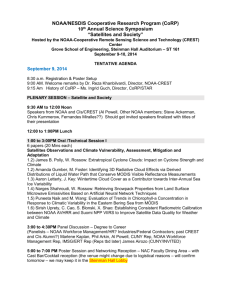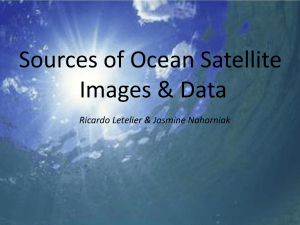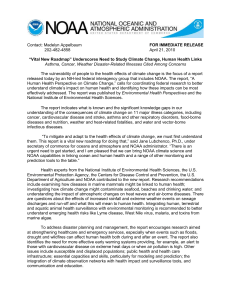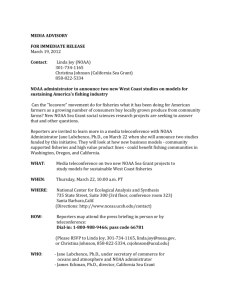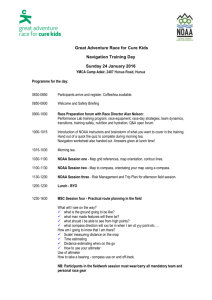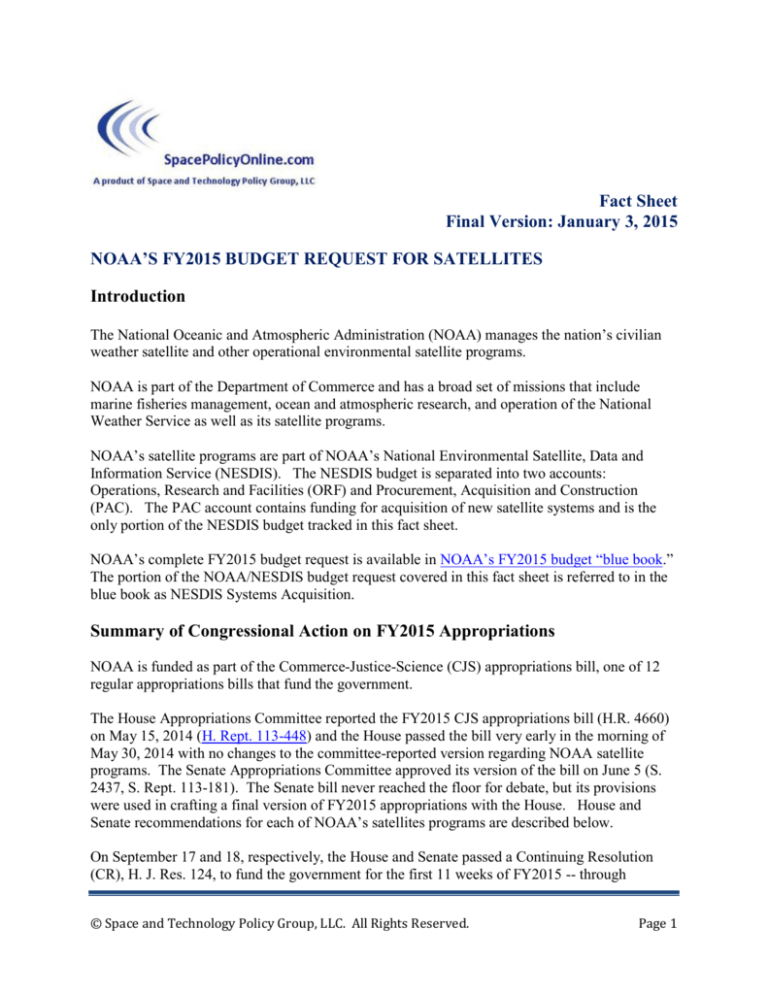
Fact Sheet
Final Version: January 3, 2015
NOAA’S FY2015 BUDGET REQUEST FOR SATELLITES
Introduction
The National Oceanic and Atmospheric Administration (NOAA) manages the nation’s civilian
weather satellite and other operational environmental satellite programs.
NOAA is part of the Department of Commerce and has a broad set of missions that include
marine fisheries management, ocean and atmospheric research, and operation of the National
Weather Service as well as its satellite programs.
NOAA’s satellite programs are part of NOAA’s National Environmental Satellite, Data and
Information Service (NESDIS). The NESDIS budget is separated into two accounts:
Operations, Research and Facilities (ORF) and Procurement, Acquisition and Construction
(PAC). The PAC account contains funding for acquisition of new satellite systems and is the
only portion of the NESDIS budget tracked in this fact sheet.
NOAA’s complete FY2015 budget request is available in NOAA’s FY2015 budget “blue book.”
The portion of the NOAA/NESDIS budget request covered in this fact sheet is referred to in the
blue book as NESDIS Systems Acquisition.
Summary of Congressional Action on FY2015 Appropriations
NOAA is funded as part of the Commerce-Justice-Science (CJS) appropriations bill, one of 12
regular appropriations bills that fund the government.
The House Appropriations Committee reported the FY2015 CJS appropriations bill (H.R. 4660)
on May 15, 2014 (H. Rept. 113-448) and the House passed the bill very early in the morning of
May 30, 2014 with no changes to the committee-reported version regarding NOAA satellite
programs. The Senate Appropriations Committee approved its version of the bill on June 5 (S.
2437, S. Rept. 113-181). The Senate bill never reached the floor for debate, but its provisions
were used in crafting a final version of FY2015 appropriations with the House. House and
Senate recommendations for each of NOAA’s satellites programs are described below.
On September 17 and 18, respectively, the House and Senate passed a Continuing Resolution
(CR), H. J. Res. 124, to fund the government for the first 11 weeks of FY2015 -- through
© Space and Technology Policy Group, LLC. All Rights Reserved.
Page 1
December 11, 2014 -- because none of the regular appropriations bills had cleared Congress.
Agencies including NOAA were funded at their FY2014 levels minus a 0.0544 percent acrossthe-board reduction to fund new activities approved in the bill. The bill allowed flexibility in
funding NOAA’s JPSS and GOES-R weather satellite programs in order to maintain their
planned launch dates.
On December 9, the Consolidated and Further Continuing Appropriations Act, 2015 was
introduced as a compromise between the House and Senate on all 12 regular appropriations bills.
It is colloquially called the “CRomnibus” because it is a mix of a CR for the Department of
Homeland Security (DHS) and an omnibus for everyone else. An “omnibus” combines most or
all of the 12 regular appropriations bills into one to expedite congressional consideration. In this
case, the omnibus includes 11 of the 12 and they received full-year funding through the end of
fiscal year 2015 (September 30, 2015). DHS is the 12th and received only a CR until February
27, 2015 to signal Republican dissatisfaction with President Obama’s executive order on
immigration, which is part of the DHS portfolio.
The CRomnibus was introduced as a “Senate amendment to H.R. 83,” an unrelated bill that
earlier passed the House. CJS is Division B. The text of the amended bill is on GPO’s website.
The joint explanatory statement is currently on a House website, though that may change at the
end of the 113th Congress. Scroll down to the heading “Senate amendment to H.R. 83” to see
links to the various divisions of the bills. NOAA is in “Division B,” the CJS portion. (The bill
and statement also are available on SpacePolicyOnline.com’s website; links are in a
SpacePolicyOnline.com article published December 13. Note that H.R. 83 originally was a bill
concerning the Department of the Interior and was reported from committee and passed the
House during the summer. It was used as the legislative vehicle for the CRomnibus even though
it was on an unrelated topic. Information about the bill before December 9 is not relevant to the
FY2015 appropriations debate.)
The CRomnibus was very controversial for reasons unrelated to NOAA. Conservative
Republicans objected because it did not send a stronger message to President Obama about their
dissatisfaction over his executive order on immigration, liberal Democrats were angry at a
provision that changed the Dodd-Frank financial regulations, and members of both parties were
unhappy about changes to campaign finance laws. Ultimately, however, the bill passed the
House by a narrow vote (216-206) on December 11, 2014, hours before the CR was due to
expire. Since the Senate still needed time to consider the measure, another CR was passed to
keep the government operating for two more days, until Saturday, December 13.
The Senate passed the CRomnibus on December 13. It was also very controversial there, but
passed by a wider margin (56-40). The bill (H.R. 83 as amended) was signed into law on
December 16 (P.L. 113-235).
NOAA’s Satellite Programs
Responsibilities for government weather, land imaging, and earth science satellites are split
among several agencies. NOAA manages the nation’s civilian weather satellites and other
© Space and Technology Policy Group, LLC. All Rights Reserved.
Page 2
operational environmental satellite programs. NASA builds and launches earth science satellites
for research and technology development purposes. The U.S. Geological Survey operates the
government’s Landsat land remote sensing satellites. The Department of Defense (DOD) has its
own weather satellite program as well as classified satellites for intelligence gathering. This fact
sheet covers only NOAA’s satellite programs.
Weather Satellites
NOAA operates two complementary weather satellite systems:
•
Polar Orbit. One system is in polar orbit where the satellites circle Earth’s poles,
allowing them to view the entire planet. NOAA’s current polar orbit satellites are called
POES – Polar Orbiting Environmental Satellites. Once in orbit, they are given a
designation of “NOAA” followed by a number. NOAA-19, the last of the series, was
launched in 2009. NOAA is now developing a follow-on system called Joint Polar
Satellite System (JPSS). The first is expected to be launched in FY2017.
Because of the long gap between NOAA-19 and JPSS-1, NOAA is using a satellite
developed by NASA, Suomi-NPP, as an operational weather satellite even though it was
not designed for operational duties and has only a three-year design life. NOAA and
other policy makers are concerned that NOAA-19 and Suomi-NPP might cease
functioning before JPSS-1 is launched and a “gap” in weather satellite coverage will
occur. There is similar concern that a gap may develop between JPSS-1 and JPSS-2,
which is expected to be launched in FY2022 according to NOAA’s launch schedule.
The Senate Appropriations Committee expressed concern about the potential gap
between Suomi NPP and JPSS-1 in its report on the FY2015 CJS appropriations bill and
said NOAA’s priority must be mitigating against such a gap. It directed NOAA to
provide a report detailing what it is doing in that regard, including “viable proposals for a
gap filler...” It recommended zero funding for SIDAR and transferring Jason-3 and
DSCOVR to NASA as part of its emphasis on NOAA prioritizing weather satellites.
The Senate committee’s recommendation to transfer DSCOVR and Jason-3 to NASA
was not adopted in the CRomnibus, however, and about half of the funding was provided
for SIDAR (see below).
JPSS received its full request of $916 million in the CRomnibus.
•
Geostationary Orbit. The other system is in geostationary orbit 35,800 kilometers
above the equator where satellites maintain a fixed position relative to a point on Earth.
Such weather satellites are especially useful for monitoring tropical regions where
hurricanes form. NOAA keeps one Geostationary Operational Environmental Satellite
(GOES) over the eastern region of the United States and adjacent waters and another over
the western region. Whatever satellites are in those positions are designated “GOESEast” and “GOES-West.” NOAA also keeps a spare satellite in between those two
positions that can be moved quickly to replace a malfunctioning satellite if necessary (as
© Space and Technology Policy Group, LLC. All Rights Reserved.
Page 3
happened in 2012 and 2013). The GOES-13 satellite is now GOES-East and GOES-15
is GOES-West, with GOES-14 as the spare.
NOAA is procuring four new GOES satellites – a block buy called the GOES-R series.
At this point they have letter designations (GOES-R, -S, -T and –U), which will change
to numbers once they are in orbit. GOES-R itself is expected to launch in FY2016
according to NOAA’s launch schedule.
GOES-R received its full request of $981 million in the CRomnibus.
Other Operational Environmental Satellites
NOAA also is responsible for four other satellite projects in partnership with NASA, the Air
Force or other countries.
•
DSCOVR. The Deep Space Climate Observatory (DSCOVR) will monitor “space
weather” caused by particles ejected by the Sun that impact Earth’s atmosphere and can
result in satellite failures or power outages on Earth, for example. DSCOVR originated
at NASA during the Clinton Administration, but became enmeshed in politics because it
was advocated by Vice President Al Gore and criticized by Republicans. Originally
called Triana, it was put into storage during the George H. Bush Administration where it
remained until the Obama Administration resurrected it. NASA, NOAA and the Air
Force are now jointly funding it because all three need space weather data and the
satellites currently providing that data are very old.
The Senate Appropriations Committee recommended that DSCOVR (and Jason-3) be
transferred to NASA and shifted funding from the NOAA budget to NASA in its report
on the FY2015 CJS appropriations bill. DSCOVR would have received $21.1 million in
NASA’s budget if the Senate committee’s position was adopted, the same as NOAA’s
request.
The Senate committee’s recommendation to transfer DSCOVR to NASA was not
adopted in the CRomnibus, however, which provides $21.1 million in NOAA’s budget.
DSCOVR is scheduled for launch in January 2015.
•
Jason-3. This is the third in a series of Jason satellites that provide ocean altimetry data.
The first two were experimental and funded by NASA and its French counterpart, CNES.
The data collection is now transitioning into an operational mode so Jason-3 is funded by
NOAA and the European Organisation for the Exploitation of Meteorological Satellites
(EUMETSAT), as well as CNES.
The Senate Appropriations Committee recommended that Jason-3 (and DSCOVR) be
transferred to NASA and shifted funding from the NOAA budget to NASA in its report
on the FY2015 CJS appropriations bill. Jason-3 would have received $25.6 million in
NASA’s budget if the Senate committee’s position was adopted, about the same as what
NOAA requested.
© Space and Technology Policy Group, LLC. All Rights Reserved.
Page 4
The Senate recommendation to transfer Jason-3 to NASA was not adopted in the
CRomnibus, however, which provides $23.2 million in NOAA’s budget. It is scheduled
for launch in March 2015.
•
COSMIC-2. The Constellation Observing System for Meteorology, Ionosphere and
Climate (COSMIC)-2 program is a constellation of small satellites, built by NOAA in
cooperation with Taiwan and the U.S. Air Force, that uses signals from the Global
Positioning Satellite (GPS) system for radio occultation (GPS-RO, or alternatively
GNSS-RO for Global Navigation Satellite System-Radio Occultation) to enhance the
accuracy of polar-orbiting weather satellites.
The Obama Administration requested no NOAA funding for COSMIC-2 in FY2014, but
Congress added $2 million (a compromise between $4 million added by the Senate and
zero added by the House). For FY2015, it is requesting $6.8 million. During an April
hearing, the top Republican on the Senate Appropriations Committee, Sen. Richard
Shelby (R-AL), questioned the need for this program. Two prominent earth scientists,
Rick Anthes and Thomas Bogdan, wrote an op-ed in the Washington Post explaining why
they consider it a “crucial element” in enhancing weather prediction.
In its report on the FY2015 CJS bill, the Senate appropriations committee fully supported
COSMIC-2. Six satellites are planned for launch in FY2018 as the first phase of
COSMIC-2 and the committee wants a “comprehensive plan” for the second phase as
well as an analysis of acquiring data from private sector providers.
COSMIC-2 received its full request of $6.8 million in the CRomnibus.
• SIDAR. The Solar Irradiance, Data and Rescue (SIDAR) program replaces the Polar
Free Flyer (PFF) in NOAA FY2014 budget request. NOAA requested $62 million for
PFF in FY2014, but Congress zeroed it and told NOAA to come up with a new strategy
for launching the three instruments – Total Solar Irradiance Sensor (TSIS), Advanced
Data Collection System (A-DCS), and Search and Rescue Satellite-Aided Tracking
(SARSAT).
These instruments were originally intended to be launched along with the instruments
that now will be on JPSS (as well as other instruments) on National Polar-orbiting
Operational Environmental Satellite System (NPOESS) satellites. The NPOESS program
was initiated in 1994 to merge the separate weather satellite systems operated by NOAA
and DOD, but after more than 15 years of cost overruns and schedule delays, the Obama
Administration terminated NPOESS in 2010 and told NOAA and DOD to return to
separate systems. JPSS is NOAA’s replacement for its part of NPOESS, but the JPSS
spacecraft are too small to accommodate these three instruments and NOAA is trying to
find an alternative way to get them into orbit.
© Space and Technology Policy Group, LLC. All Rights Reserved.
Page 5
SIDAR is the latest attempt. The House zeroed it in its version of the FY2015 CJS
appropriations bill and the Senate Appropriations Committee also recommended zero.
The Senate committee stressed that NOAA’s focus must be weather-related satellites and
mitigating the potential gap in polar-orbiting weather satellite coverage discussed above.
In the CRomnibus, however, SIDAR receives $7.3 million to support accommodating the
TSIS-1 instrument on the International Space Station (ISS) and to maintain international
partnerships on SARSAT and A-DCS. The conferees note that hosting TSIS-1 on the
ISS was not part of the President’s FY2015 budget request and ask for a report on the
revised plan.
The PAC account in NESDIS also funds satellite ground services; systems architecture and
advanced planning; and projects, planning and analysis.
© Space and Technology Policy Group, LLC. All Rights Reserved.
Page 6
NOAA’s FY2015 Budget Request for Satellite System Acquisition and Congressional Action
(in $ thousands)
Program
GOES-R
Jason-3
JPSS
SIDAR
DSCOVR
COSMIC-2
Satellite Ground
Services
Sys Architecture &
Adv Planning
Projects, Planning
& Analysis
TOTAL
FY2014 enacted
FY2015 Request
House Approps
Senate Approps
Final
(passed )
(committee) note 3
981,000
980,838
15,000 transferred to NASA
916,500
916,267
0
0
20,000 transferred to NASA
6,800
6,800
941,899
18,500
820,855
see note 2
23,675
2,000
980,838
25,656
916,267
15,000
21,100
6,800
49,734
52,717
52,715
52,136
50,000
4,587
4,587
4,393
4,000
3,000
33,488
33,488
33,488
25,200
25,200
1,894,738
2,056,453
2,029,896
1,985,241
2,033,680
note 3
980,838
23,175
916,267
7,300
21,100
6,800
Source: Budget request data from NOAA’s FY2015 budget blue book. House appropriations figures are from H. Rept. 113-448, the report to accompany the
FY2015 Commerce-Justice-Science appropriations bill (H.R. 4660). The House passed the bill with no changes to NOAA satellite programs on May 30, 2014.
Senate appropriations figures are from the committee’s report (S. Rept. 113-181). The final figures are from the joint explanatory statement accompanying the
Consolidated and Further Continuing Appropriations Act, 2015 – the CRomnibus (H.R. 83 as amended).
Note 1: This fact sheet does not track spending for the other NESDIS budget account, Operations, Research and Facilities (ORF).
Note 2: In FY2014, this was called Polar Free Flyer (PFF). NOAA requested $62 million; Congress zeroed it.
Note 3: The Senate report includes another line – “satellite CDA facility” – for $2,166,000 that is not tracked in this fact sheet and not included in the total shown
here. Including it would raise the total to $1,987,407,000. That amount is included in the proposed compromise omnibus appropriations bill.
© Space and Technology Policy Group, LLC. All Rights Reserved.
Page 7


